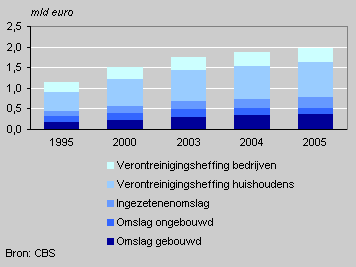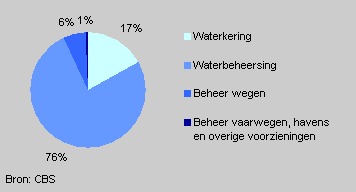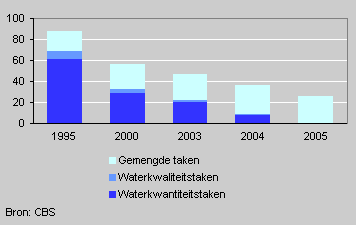Water board taxes increase by 4 percent

The revenues of water boards will increase in 2005 by an average 4 percent. The increase is moderate compared to 2004 when revenues grew by 7 percent.
Water board taxes slightly up
Water boards impose two types of levies to cover their costs, i.e. poll tax and pollution tax. Poll tax serves to cover the costs of water quantity management.
Pollution tax is imposed to cover the costs of water quality management. Poll taxes will rise by 5 percent in 2005, pollution tax by 4 percent.
Revenues of water board taxes

Water management largest cost component
Poll taxes imposed by water boards can be subdivided into poll tax paid by households, poll tax paid by landowners and poll tax paid by owners of houses and non-residential buildings.
Within the category poll taxes the costs shift from landowners, for instance farmers, to residents. The latter will face a tax increase by 10 percent in 2005. Three-quarters of the revenues of poll taxes imposed by water boards are intended to cover the costs of water control. Water control includes control of the groundwater level by means of pumping-stations, dams and locks, maintenance of waterways and construction of water storage facilities. The remaining quarter is spent on management, protection and maintenance of embankments, coastal sand dunes and inland waterways.
Costs of water quality management

Lower pollution tax rate for the private sector
Households pay an increasing part of the pollution tax. The private sector has taken precautionary measures in recent years to reduce the discharge of polluted waste water and therefore is subject to lower tax rates. In 2005 the proportion of pollution tax paid by the private sector will amount to 28 percent, whereas in 1995 the proportion was 33 percent.
Number of water boards decreasing further
As from 1 January 2005 the number of water boards has been reduced by 10 to 26. In 1955 there were still 2,480 water boards in the Netherlands. By merging smaller water board districts, responsible for water quantity management into larger districts, their number was reduced to 255 in 1985. In the mid-1990s many water boards merged into organisations with a mixed set of duties. These water boards are responsible for water quantity management (the construction and maintenance of dams, embankments, dikes, locks and water level control) as well as water quality management (clean surface water).
Number of water boards by set of duties

In 2005 the number of water boards will be reduced mainly because a number of water board districts will merge in the province of South Holland.
All water boards now have several responsibilities. In 1995 only one quarter of water boards had a mixed set of duties.
Mattheus Wassenaar